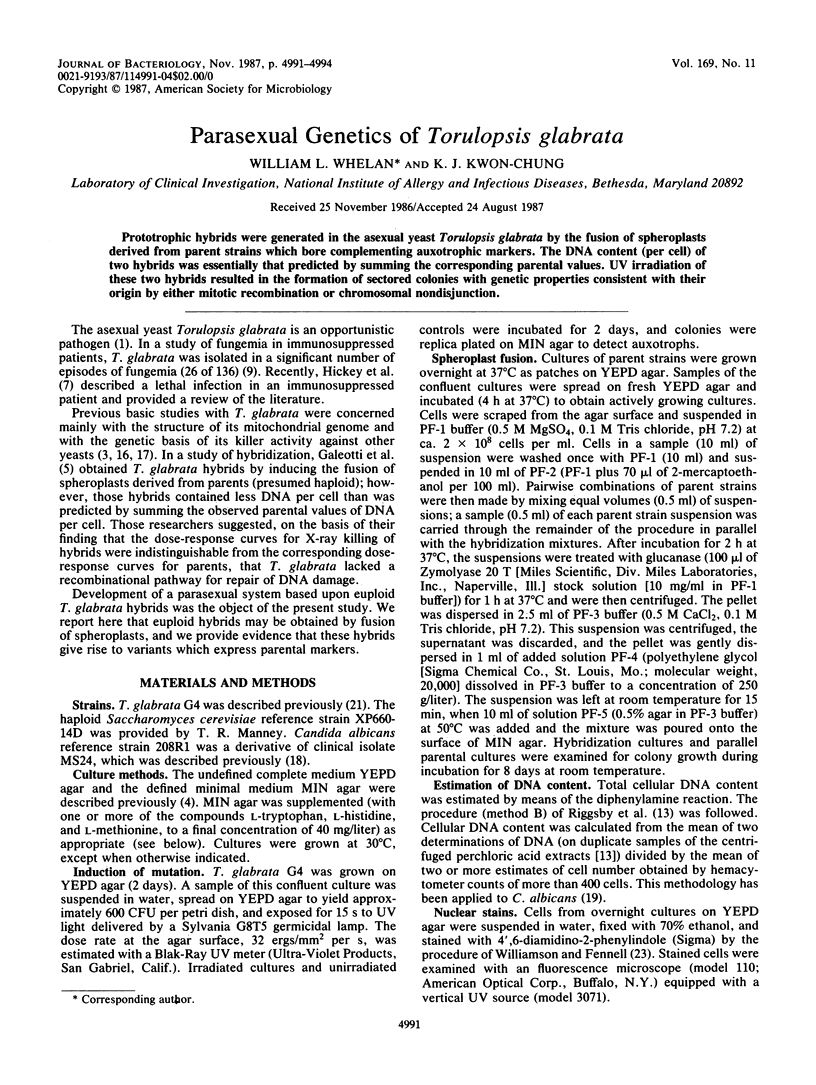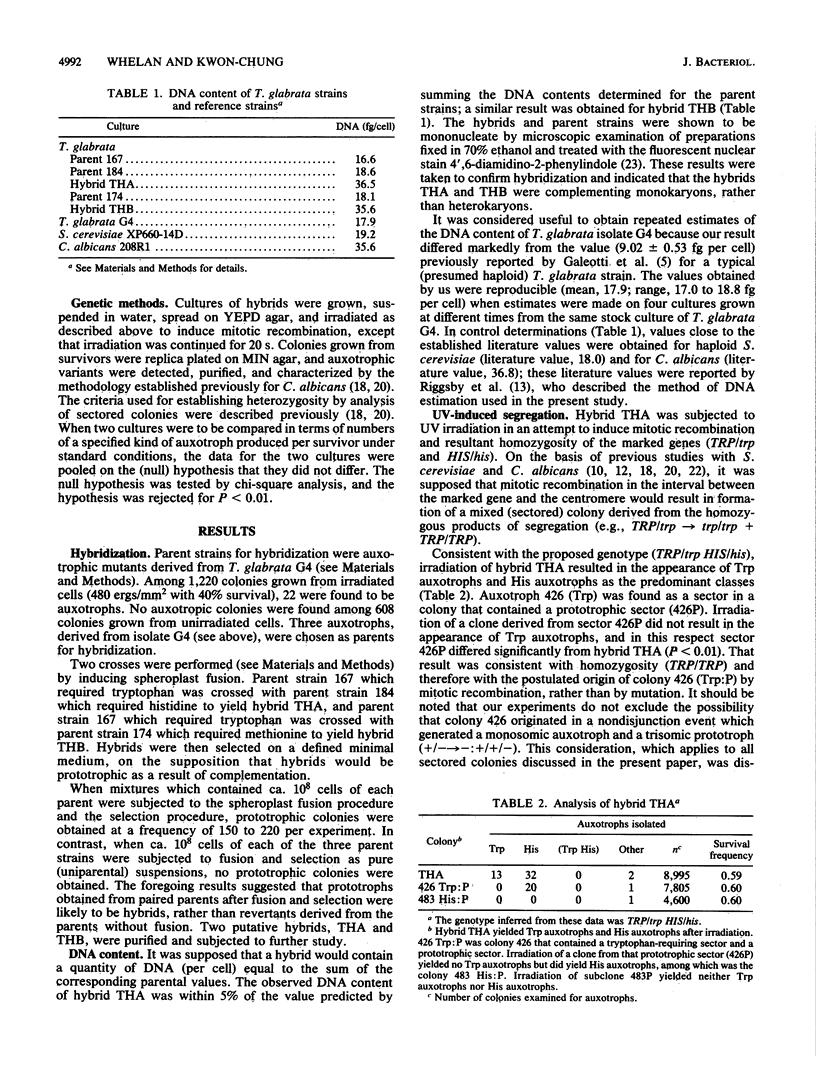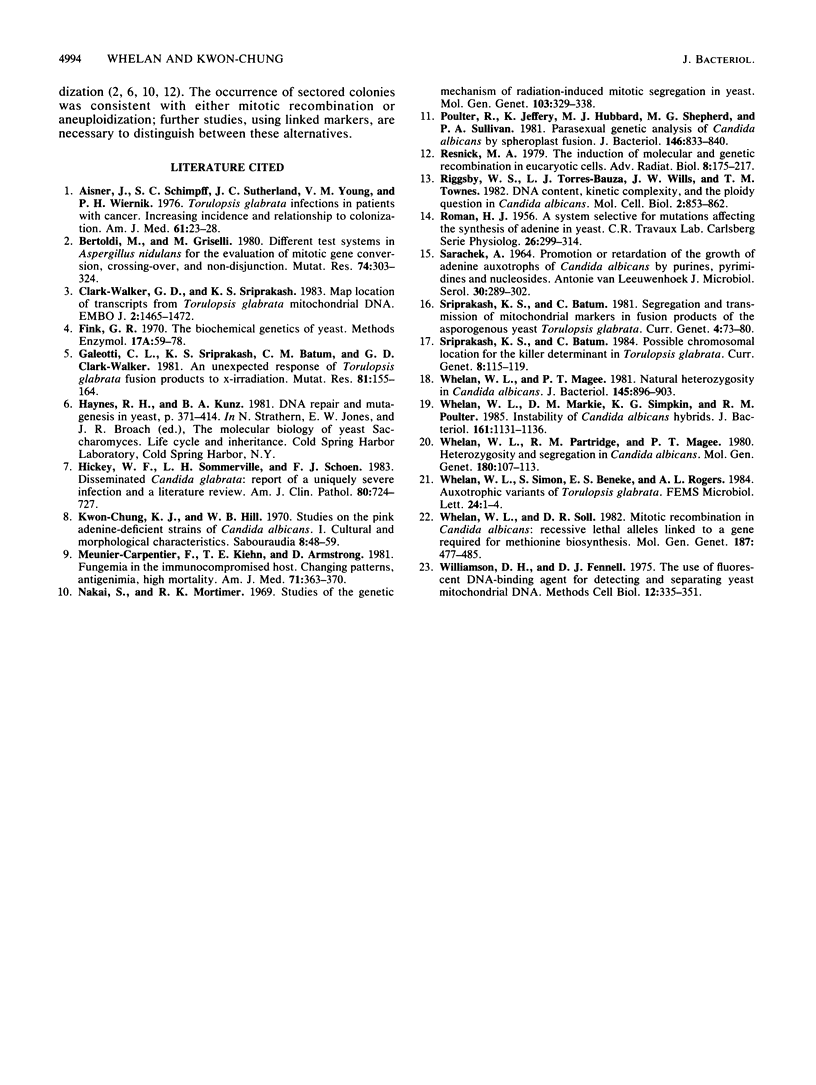Abstract
Prototrophic hybrids were generated in the asexual yeast Torulopsis glabrata by the fusion of spheroplasts derived from parent strains which bore complementing auxotrophic markers. The DNA content (per cell) of two hybrids was essentially that predicted by summing the corresponding parental values. UV irradiation of these two hybrids resulted in the formation of sectored colonies with genetic properties consistent with their origin by either mitotic recombination or chromosomal nondisjunction.
Full text
PDF



Selected References
These references are in PubMed. This may not be the complete list of references from this article.
- Aisner J., Schimpff S. C., Sutherland J. C., Young V. M., Wiernik P. H. Torulopsis glabrata infections in patients with cancer. Increasing incidence and relationship to colonization. Am J Med. 1976 Jul;61(1):23–28. doi: 10.1016/0002-9343(76)90026-7. [DOI] [PubMed] [Google Scholar]
- Chung K. J., Hill W. B. Studies on the pink, adenine-deficient strains of Candida albicans. I. Cultural and morphological characteristics. Sabouraudia. 1970 May;8(1):48–59. [PubMed] [Google Scholar]
- Clark-Walker G. D., Sriprakash K. S. Map location of transcripts from Torulopsis glabrata mitochondrial DNA. EMBO J. 1983;2(9):1465–1472. doi: 10.1002/j.1460-2075.1983.tb01609.x. [DOI] [PMC free article] [PubMed] [Google Scholar]
- Galeotti C. L., Sriprakash K. S., Batum C. M., Clark-Walker G. D. An unexpected response to Torulopsis glabrata fusion products to X-irradiation. Mutat Res. 1981 Apr;81(2):155–164. doi: 10.1016/0027-5107(81)90030-0. [DOI] [PubMed] [Google Scholar]
- Hickey W. F., Sommerville L. H., Schoen F. J. Disseminated Candida glabrata: report of a uniquely severe infection and a literature review. Am J Clin Pathol. 1983 Nov;80(5):724–727. doi: 10.1093/ajcp/80.5.724. [DOI] [PubMed] [Google Scholar]
- Meunier-Carpentier F., Kiehn T. E., Armstrong D. Fungemia in the immunocompromised host. Changing patterns, antigenemia, high mortality. Am J Med. 1981 Sep;71(3):363–370. doi: 10.1016/0002-9343(81)90162-5. [DOI] [PubMed] [Google Scholar]
- Nakai S., Mortimer R. K. Studies on the genetic mechanism of radiation-induced mitotic segregation in yeast. Mol Gen Genet. 1969;103(4):329–338. doi: 10.1007/BF00383483. [DOI] [PubMed] [Google Scholar]
- Poulter R., Jeffery K., Hubbard M. J., Shepherd M. G., Sullivan P. A. Parasexual genetic analysis of Candida albicans by spheroplast fusion. J Bacteriol. 1981 Jun;146(3):833–840. doi: 10.1128/jb.146.3.833-840.1981. [DOI] [PMC free article] [PubMed] [Google Scholar]
- Riggsby W. S., Torres-Bauza L. J., Wills J. W., Townes T. M. DNA content, kinetic complexity, and the ploidy question in Candida albicans. Mol Cell Biol. 1982 Jul;2(7):853–862. doi: 10.1128/mcb.2.7.853. [DOI] [PMC free article] [PubMed] [Google Scholar]
- SARACHEK A. PROMOTION OF RETARDATION OF THE GROWTH OF ADENINE AUXOTROPHS OF CANDIDA ALBICANS BY PURINES, PYRIMIDINES AND NUCLEOSIDES. Antonie Van Leeuwenhoek. 1964;30:289–302. doi: 10.1007/BF02046735. [DOI] [PubMed] [Google Scholar]
- Whelan W. L., Magee P. T. Natural heterozygosity in Candida albicans. J Bacteriol. 1981 Feb;145(2):896–903. doi: 10.1128/jb.145.2.896-903.1981. [DOI] [PMC free article] [PubMed] [Google Scholar]
- Whelan W. L., Markie D. M., Simpkin K. G., Poulter R. M. Instability of Candida albicans hybrids. J Bacteriol. 1985 Mar;161(3):1131–1136. doi: 10.1128/jb.161.3.1131-1136.1985. [DOI] [PMC free article] [PubMed] [Google Scholar]
- Whelan W. L., Partridge R. M., Magee P. T. Heterozygosity and segregation in Candida albicans. Mol Gen Genet. 1980;180(1):107–113. doi: 10.1007/BF00267358. [DOI] [PubMed] [Google Scholar]
- Whelan W. L., Soll D. R. Mitotic recombination in Candida albicans: recessive lethal alleles linked to a gene required for methionine biosynthesis. Mol Gen Genet. 1982;187(3):477–485. doi: 10.1007/BF00332632. [DOI] [PubMed] [Google Scholar]
- Williamson D. H., Fennell D. J. The use of fluorescent DNA-binding agent for detecting and separating yeast mitochondrial DNA. Methods Cell Biol. 1975;12:335–351. doi: 10.1016/s0091-679x(08)60963-2. [DOI] [PubMed] [Google Scholar]


